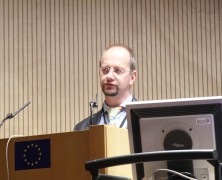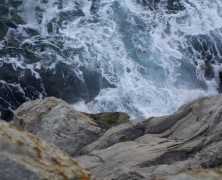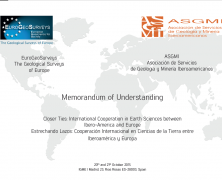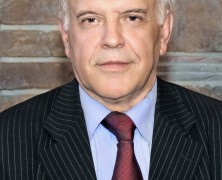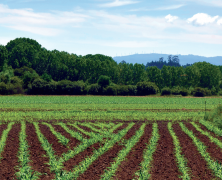The Launch of the European Minerals Yearbook at the Raw Materials Diplomacy Dialogue between the EU and advanced mining...
Segovia brings together the Directors of EGS-ASGMI Geological Surveys: a perspective from the Spanish press
posted by EuroGeoSurveys
The Spanish newspapers “Adelantado de Segovia” and “El Norte de Castilla” reported about the EuroGeoSurveys (EGS) -Association of Geological and Mining Surveys of Ibero-America (ASGMI) Workshop held in Madrid from the 19th to 23rd of October, of which field trip “Urban geology and natural risks inside the city of Segovia” took place in Segovia on the 22nd October. The meeting of the Directors of the Geological Surveys of Europe and Latin American, as well as USA and Canada, has been particularly welcomed by the local press. The Memorandum of Understanding signed between EGS and ASGMI represents indeed a historical moment, possibly leading to funding opportunities for geological cooperation between the two continents under Horizon 2020. Moreover, the field trip allowed participants to discover the geological heritage of Segovia, and see a place where the human activities interfered with the geological process since more than 60,000 years, producing situations of natural risks and the exploitation of geological resources. The full article are available in Spanish: 2015-10-23, El Norte de Castilla, pag 12 2015-10-23, El Adelantado de Segovia, pag 14 2015-10-22, El Norte de Castilla, pag 8 2015-10-20, El Adelantado de Segovia, pag 10...
EMODnet Open Conference: Unlocking the wealth of Marine data Observation
posted by EuroGeoSurveys
On the 20th October 2015 the EMODnet Open Conference “Consolidating the Foundations, Building the Future” was held at the Grote Post in Oostende, Belgium, gathering more than 300 participants. The event aimed at reinforcing the foundations and considering avenues for the further development of an open, user‐friendly and fit‐ For‐Purpose pan-European Marine data infrastructure. Blue Growth and Blue Economy have been at the centre of the debate. In his welcoming speech, MEP João Ferreira reiterated the attention of the European Parliament for establishing a sustainable blue economy. It is estimated that between 3 and 5 % of the EU’s GDP comes from the overall maritime sector, which employs around 5,6 million people and generates EUR 495 billion for the European economy. Therefore a more comprehensive approach is necessary, taking into account all sectoral and inter-sectoral activities. In this process, marine data access and availability become crucial issues. There is a serious lack of data concerning our seas and oceans. The European Marine Observation and Data Network EMODnet responds to this problem by compiling and distributing marine data bundled in 7 different themes. The data are accessible from one single platform (the EMODnet portals), and are harmonized and interoperable. EMODnet-Geology currently includes 36 organizations providing data, most of which are National Geological Surveys. During the second phase of EMODnet, which ends in October 2016, the benefits of the portal have been proven with concrete applications in Marine Spatial Planning. Mr Alan Stevenson, leader of EMODnet-Geology and co-Chair of EuroGeoSurveys Marine Geology Expert Group, presented one example. For the first Regional Plan for the Trade and Sea Area in Finland, drawn up by the Regional Council of Kymenlaakso for the Baltic Sea, Finnish marine geologists interacted with planners in order to evaluate what kind of environmental...
PRESS RELEASE: GEOLOGY CONNECTS TWO CONTINENTS
posted by EuroGeoSurveys
PRESS RELEASE GEOLOGY CONNECTS TWO CONTINENTS • More than 50 General Directors of the Geological Surveys of 20 Latin American countries and 34 European countries, together with the United States and Canada, will gather in Madrid from the 19th to the 23rd October to explore new ways of cooperation. • EuroGeoSurveys, the Geological Surveys of Europe, and the Association of Geological and Mining Surveys of Ibero-America (ASGMI), will celebrate the Annual Assembly at IGME Headquarters. IGME is member of both organizations and will host the meeting. This combination of national geological organizations of both continents has never happened before, therefore representing a historically relevant fact. • EGS and ASGMI will share a joint two day-workshop titled “Closer Ties: International Cooperation in Earth Sciences between Ibero-America and Europe” and will sign, for the first time in history, a collaboration agreement that will involve more than 14.000 professionals working within the members of the both organizations, which joint budgets will reach 1.500M€. • The World Bank and the European Commission (Directorate General for Internal Market, Industry, Entrepreneurship and SMEs and Directorate General for Development and Cooperation) will contribute with proposals for financing the Earth Sciences cooperation between the two sides of Atlantic. Madrid, 16th October 2015 The Workshop (that will be held in English and Spanish with simultaneous translation at the Gomez Pardo Foundation c/Alenza no. 1 on the 20th and 21st October) will be inaugurated by Marina Villegas, Director General of Technical and Scientific Research of the Ministry of Economy and Competitiveness, together with Jorge Civis, IGME Director, Santiago J. Muñoz Tapia, ASGMI President, and Koen Verbruggen, EGS President. The Workshop will focus on geological risks, mining and environmental conflicts, as well as institutional strengthening, for which will be studied possible European and international sources...
The new video by IGME available in English and Portuguese! Watch “THE GEOLOGICAL MAP: Drawing the Earth’s skin”...
posted by EuroGeoSurveys
The new video by the Geological Survey of Spain (IGME) available in English and Portuguese THE GEOLOGICAL MAP Drawing the Earth’s skin O MAPA GEOLOGICO Desenhando a pele da...
TAXPAYER FUNDED BOOST FOR EUROPEAN MINING INDUSTRY
posted by EuroGeoSurveys
PRESS RELEASE TAXPAYER FUNDED BOOST FOR EUROPEAN MINING INDUSTRY Brussels, 15 October In the wake of global economic slowdown and collapsing commodity prices, mining companies and consumers of minerals need to be ever more cost conscious if they are to survive. On the 15th October, the European Minerals Yearbook, first digital reliable source of information on minerals statistics and intelligence in Europe, was officially launched at the “Raw Materials Diplomacy Dialogue between the EU and Advanced Mining Countries” organized by the European Commission DG GROW and EASME in Brussels. Including 40 European countries, 65 commodities from primary minerals with a focus on the twenty critical raw materials for the EU, covering a 10-year span for production and trade, the Yearbook is meant to reduce costs and risks, and secure sustained supplies for European industries in the mining and manufacturing sectors. This comprehensive database contains detailed production pan-European information, therefore providing a new tool to the industry and EU decision-makers which before had to rely on fragmented and/or non-official sources. As MEP Mr Andrejs Mamikins stated: “The European Minerals Yearbook is a great achievement. It could, for instance, reinvigorate also my home country Latvia’s economy through a more efficient extraction and subsequent use of natural resources. It could allow Europe to be much more self-sufficient and not overly dependent on the United States Geological Survey agency. It is my hope that the newest yearbook shall open a new page in Europe’s quest for increased competitiveness and prosperity”. In his speech, Mr David Mair, Director for Policy Support Coordination at the Joint Research Centre of the European Commission, strongly supported the strategic cooperation between the JRC and EuroGeoSurveys to transfer knowledge and scientific evidence into policy. The Yearbook information is intended to be used by...
Launch of the European Minerals Yearbook
posted by EuroGeoSurveys
On 15th October 2015, in Brussels, the first official European Minerals Yearbook will be launched in the frame of the next Raw Materials Diplomacy Dialogue between the EU and advanced mining countries event, organised by the European Commission’s DG Grow and EASME. The event will be opened by the DG GROW Director Mr. Gwenole Cozigou and by MEP Mr R. Buetikofer. Mr Andrew Bloodworth, Science Director for Minerals and Waste from the British Geological Survey will explain how this innovative comprehensive source of minerals statistics can facilitate for the first time the European Union decision-making on investment planning and can be used to benefit the European economy, industrial development and trade and the lives of European citizens. Alongside data for primary minerals, the European Minerals Yearbook includes available data for mineral-based waste generation, treatment and trade. It presents national level statistical data for 40 European countries for the last ten-year period 2004 to 2013. All the data are accessible digitally through the European Minerals Knowledge Data Platform and provide the resource potential of primary and secondary mineral sources in Europe. For more information please contact the EuroGeoSurveys Secretariat http://www.minerals4eu.eu/...
Interview with Mr. Dragoman Rabrenović, Director of the Geological Survey of Serbia
posted by EuroGeoSurveys
The Geological Survey of Serbia (GZS) became a full member of EuroGeoSurveys (EGS) in March 2015. What are the priorities and needs for GZS in order to grow further within EuroGeoSurveys? The Geological Survey of Serbia, which dates back to 1930, has a long and well established history, with internationally recognised professional expertise. Being a full member of EuroGeoSurveys is very important for us. This is in accordance with the strategy of our Survey too. It is an occasion to follow the latest professional trends worldwide, which represents an advantage and a way for every European Geological Survey to increase its international presence. Geology has no borders, and geological practice needs international cooperation. Our priority is to see EGS and GZS in a mutually beneficial ‘win-win’ situation. In order to exchange professional experiences, especially within the new technologies domain, we need well-established cooperation with other Geological Surveys across the EU. Our Survey is going to support our colleagues to join the existing EGS Expert Groups. Serbia is officially a candidate country to become a member of the EU and negotiations with Serbia have already been opened. How would you describe the benefits/consequences of such a milestone for geological survey cooperation? It is clearly important to harmonize EU and RS regulations , and in this instance, those that apply to our profession. EGS provides a focal point for various appropriate professional experiences and this will be another advantage. Our Survey has obligations and plays an active role in creating national regulations relevant to geology. In the landscape of Balkan countries, the Geological Survey of Serbia is quite a large institution and could potentially put cooperation on the right track in several geological domains with neighboring countries. How would you see such a role? For the...
GEMAS: a review by Steve McGrath
posted by EuroGeoSurveys
A review of the GEMAS Atlas by Steve McGrath, one of the top soil scientists in Europe, on the August issue of Elements Magazine “Social and Economic Impacts of Geochemistry”. CHEMISTRY OF EUROPE’S AGRICULTURAL SOILS This two volume set (Parts A and B) arose from a project called the Geochemical Mapping of Agricultural and Grazing Land Soil in Europe (GEMAS). In this project, 2108 soil samples from ploughed land (0–20 cm depth)and 2023 samples of grazing land (0–10 cm depth) were collected in 2008/9 over an area of 5.6 million km2, at a density of about 1 per 2,500 km2. This was accomplished by a tremendous consortium of European national geological surveys, geologic institutions, academics, and industry. These groups used the same sampling protocols, with chemical analyses of all samples being carried out at specific labs. This ensured maximum comparability of the results from 33 countries across Europe. Oh, except Albania, Belarus, Malta, Moldova and Romania, which appear as blank spaces on the maps. Others outside Europe were also involved, from Australia, Canada and New Zealand. It was a truly international effort. I hear you ask, “What chemical analyses did they make on these samples?” Well, quite a lot: too many to list here, in fact. In summary: total elemental analysis for 41 elements, aqua regia extractions for 53 elements, pH, effective cation exchange capacity (eCEC), total carbon, total organic carbon, lead isotopes, magnetic susceptibility, partial extractions for 56 elements, percent clay, and solid–liquid partitioning of elements. A real data-fest! Apparently, the project is not finished: for example, Sr isotope data are now being collected. Keep reading… Download the...
The new Video “EL MAPA GEOLÓGICO: Dibujando la piel de la Tierra” by IGME
posted by EuroGeoSurveys
The Geological Survey of Spain, the Instituto Geológico y Minero de España (IGME), published a new informative video “EL MAPA GEOLÓGICO: Dibujando la piel de la Tierra”, currently available in Spanish language and soon in English and French. The video gives an insight on how the Geological Maps are created and the work done by geologists in this...

